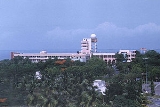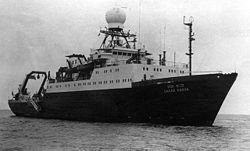
National Institute Of Oceanography, India
Encyclopedia
The National Institute of Oceanography (NIO) is one of 39 constituent laboratories
of the CSIR
- Council of Scientific and Industrial Research, an autonomous research organization in India. The institute has its headquarters in the coastal state of Goa
, and regional centres in Kochi , Mumbai
and Vizag. The Institute was established on 1 January 1966. At the end of over 40 years it has grown today into a large oceanographic laboratory of international repute mainly focusing on the understanding of special oceanographic features of the Northern Indian Ocean.
, Biological Oceanography, Chemical Oceanography
and Geological Oceanography. Related areas of its interest include Ocean Engineering
, Marine Archaeology, Instrumentation
, Marine biofuling and others. With a staff strength of 200 researchers and over 100 technical personnel, the focus of research has been on observing and understanding the special oceanographic features that the North Indian basin offers. The inferences from this research have been reported in about 6000 research articles so far. Besides this, the industry sponsors a variety of projects to the institute to carry out applied research that mainly include oceanographic data collection, environmental impact assessment, coastal zone management and coastal processes modeling studies.
The institute also supports students pursuing doctoral research in oceanography programmes under the guidance of its scientists. At present over 60 research fellows from various universities (students qualified through CSIR/UGC eligibility criterion) are engaged in research towards their degrees at the institute. In addition over 200 post-graduate students, work at the institute for short-term research projects and dissertations every year. Nearly 5% of them are from other countries.
NIO has developed an Autonomous Underwater Vehicle
(AUV) that has applications in the field of oceanographic research
. An Autonomous Surface Vehicle (ASV) has also been developed.
s are the most important research tool for oceanographic studies. NIO's scientists use following vessels at large, besides chartering others for specific purposes, for collection of data at seas.

 India's first multidisciplinary oceanographic research vessel, RV Gaveshani, was decommissioned in 1994. The vessel had originally been acquired in 1976, and performed over 200 cruises to all parts of the Indian Ocean. NIO was sanctioned Rs. 190 crore for construction of a new multi-disciplinary oceanographic research vessel. The new vessel ORV Sagar Nidhi
India's first multidisciplinary oceanographic research vessel, RV Gaveshani, was decommissioned in 1994. The vessel had originally been acquired in 1976, and performed over 200 cruises to all parts of the Indian Ocean. NIO was sanctioned Rs. 190 crore for construction of a new multi-disciplinary oceanographic research vessel. The new vessel ORV Sagar Nidhi
joined NIO in 2008. The new multi-disciplinary oceanographic research vessel has capabilities to undertake basin scare observations and will enable Indian oceanographers to take up studies in any part of the Indian Ocean. It is aimed to serve as a stable platform allowing data acquisition and operation of sensitive equipment while underway.
Laboratory
A laboratory is a facility that provides controlled conditions in which scientific research, experiments, and measurement may be performed. The title of laboratory is also used for certain other facilities where the processes or equipment used are similar to those in scientific laboratories...
of the CSIR
CSIR India
Council of Scientific and Industrial Research established in 1942, is an autonomous body and India's largest Research and Development organization, with 39 laboratories and 50 field stations or extension centers spread across the nation, with a collective staff of over 17,000...
- Council of Scientific and Industrial Research, an autonomous research organization in India. The institute has its headquarters in the coastal state of Goa
Goa
Goa , a former Portuguese colony, is India's smallest state by area and the fourth smallest by population. Located in South West India in the region known as the Konkan, it is bounded by the state of Maharashtra to the north, and by Karnataka to the east and south, while the Arabian Sea forms its...
, and regional centres in Kochi , Mumbai
Mumbai
Mumbai , formerly known as Bombay in English, is the capital of the Indian state of Maharashtra. It is the most populous city in India, and the fourth most populous city in the world, with a total metropolitan area population of approximately 20.5 million...
and Vizag. The Institute was established on 1 January 1966. At the end of over 40 years it has grown today into a large oceanographic laboratory of international repute mainly focusing on the understanding of special oceanographic features of the Northern Indian Ocean.
History
The NIO draws its roots from the International Indian Ocean Expedition (IIOE). India was one of many countries that participated in this multi-national, multi-institutional expedition and provided a base for the analysis of biological samples at Indian Ocean Biological Centre and non-biological samples at Indian Ocean Physical Oceanography Centre. During the early 60's, the CSIR felt the need for oceanographic research in the country and considered to establish this institute; incorporating the scientific manpower involved in the IIOE at the end of the expedition.Research programmes
NIO focuses on research in Physical OceanographyPhysical oceanography
Physical oceanography is the study of physical conditions and physical processes within the ocean, especially the motions and physical properties of ocean waters.Physical oceanography is one of several sub-domains into which oceanography is divided...
, Biological Oceanography, Chemical Oceanography
Chemical oceanography
Chemical oceanography is the study of ocean chemistry: the behavior of the chemical elements within the Earth's oceans. The ocean is unique in that it contains - in greater or lesser quantities - nearly every element in the periodic table....
and Geological Oceanography. Related areas of its interest include Ocean Engineering
Ocean engineering
Ocean engineering is an ambiguously defined term that may refer to:*Oceanographic engineering, also called marine electronics engineering, concerned with the design of electronic devices for use in the marine environment, such as the remote sensing systems used by oceanographers*Offshore...
, Marine Archaeology, Instrumentation
Instrumentation
Instrumentation is defined as the art and science of measurement and control of process variables within a production, or manufacturing area....
, Marine biofuling and others. With a staff strength of 200 researchers and over 100 technical personnel, the focus of research has been on observing and understanding the special oceanographic features that the North Indian basin offers. The inferences from this research have been reported in about 6000 research articles so far. Besides this, the industry sponsors a variety of projects to the institute to carry out applied research that mainly include oceanographic data collection, environmental impact assessment, coastal zone management and coastal processes modeling studies.
The institute also supports students pursuing doctoral research in oceanography programmes under the guidance of its scientists. At present over 60 research fellows from various universities (students qualified through CSIR/UGC eligibility criterion) are engaged in research towards their degrees at the institute. In addition over 200 post-graduate students, work at the institute for short-term research projects and dissertations every year. Nearly 5% of them are from other countries.
NIO has developed an Autonomous Underwater Vehicle
Autonomous Underwater Vehicle
An autonomous underwater vehicle is a robot which travels underwater without requiring input from an operator. AUVs constitute part of a larger group of undersea systems known as unmanned underwater vehicles, a classification that includes non-autonomous remotely operated underwater vehicles...
(AUV) that has applications in the field of oceanographic research
Oceanography
Oceanography , also called oceanology or marine science, is the branch of Earth science that studies the ocean...
. An Autonomous Surface Vehicle (ASV) has also been developed.
Research vessels of the NIO
Research vesselResearch vessel
A research vessel is a ship designed and equipped to carry out research at sea. Research vessels carry out a number of roles. Some of these roles can be combined into a single vessel, others require a dedicated vessel...
s are the most important research tool for oceanographic studies. NIO's scientists use following vessels at large, besides chartering others for specific purposes, for collection of data at seas.

Sagar Sukti
CRV Sagar Sukti is NIO's coastal research vessel with 23.5 m length and 6.5 m in breadth. It provides accommodation to 8 scientists, 4 officers and 8 crew on board with an endurance of 12 days.RV Sindhu Sankalp
The vessel originally built as fishing training vessel (FV Chisio Maru) by the Japanese Government in 1989 was bought by NIO in 2008. Extensive modifications have been done to convert this fishing training vessel into a multi-disciplinary research vessel. The vessel has been registered under Indian Flag with a new name RV Sindhu Sankalp. With newly laid accommodation and modern scientific facilities, RV Sindhu Sankalp will be available for the scientist community from in 2010.ORV Sagar Nidhi

ORV Sagar Nidhi
ORV Sagar Nidhi is an ice-strengthened multidisciplinary vessel operated by the National Institute of Ocean Technology, India. It was constructed at Fincantieri, Italy...
joined NIO in 2008. The new multi-disciplinary oceanographic research vessel has capabilities to undertake basin scare observations and will enable Indian oceanographers to take up studies in any part of the Indian Ocean. It is aimed to serve as a stable platform allowing data acquisition and operation of sensitive equipment while underway.
External Links
- SAGAR NIDHI Oceanic Research Vessel(ORV) inducted
- Information on SAGAR NIDHI –External Link
- Information on future ORV's of NIO,India–External Link
- Costal Hazards Website
- Digital Repository Service NIO
- Mangroves of India
- Indian Reefs
- Jobs at NIO
- Directorate General of Hydrocarbons
- National Gas Hydrates Programmes

